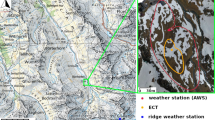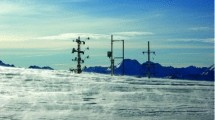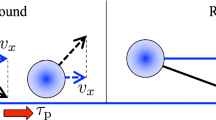Abstract
While turbulent bursts are considered critical for blowing-snow transport and initiation, the interaction of the airflow with the snow surface is not fully understood. To better characterize the coupling of turbulent structures and blowing-snow transport, observations collected in natural environments at the necessary high-resolution time scales are needed. To address this, high-frequency measurements of turbulence, blowing-snow density and particle velocity were made in the Canadian Rockies. During blowing-snow storms, modified variable-interval time averaging enabled identification of periods of near-surface blowing-snow coupling with shear-stress-producing motions in the lowest 2 m of the atmospheric surface layer. The identification of those turbulent motions responsible for blowing snow yields a better understanding of the event-driven mechanics of initiation and sustained transport. The type of coherent structures generating the Reynolds stress are just as important as the magnitude of the Reynolds stress in initiating and sustaining near-surface blowing snow. Our results suggest that blowing-snow models driven by merely the time-averaged shear stress lack physical realism in the near-surface region. The next phase of the development of blowing-snow models should incorporate parametrizations of coherent turbulent structures.







Similar content being viewed by others
References
Aksamit NO, Pomeroy JW (2016) Near-surface snow particle dynamics from particle tracking velocimetry and turbulence measurements during alpine blowing snow storms. Cryosphere 10:3043–3062. https://doi.org/10.5194/tc-10-3043-2016
Anderson RS, Haff PK (1988) Simulation of eolian saltation. Science 241:820–3. https://doi.org/10.1126/science.241.4867.820
Anderson RS (1987) Eolian sediment transport as a stochastic process: the effects of a fluctuating wind on particle trajectories. J Geol 95:497–512
Arnold S (2002) Development of the saltation system under controlled environmental conditions. Earth Surf Process Landf 27:817–829. https://doi.org/10.1002/esp.354
Baas ACW (2006) Wavelet power spectra of aeolian sand transport by boundary layer turbulence. Geophys Res Lett 33:1–4. https://doi.org/10.1029/2005GL025547
Bagnold RA (1941) The physics of blown sand and desert dunes, 1st edn. Methuen & Co. Limited, London
Bauer B, Yi J, Namikas S, Sherman D (1998) Event detection and conditional averaging in unsteady aeolian systems. J Arid Environ 39:345–375
Bauer BO, Walker IJ, Baas ACW et al (2013) Critical reflections on the coherent flow structures paradigm in aeolian geomorphology. In: Venditti JG, Best JL, Church M, Hardy RJ (eds) Coherent flow structures at earth’s surface. Wiley Blackwell, West Sussex, pp 111–134
Blackwelder R, Kaplan R (1976) On the wall structure of the turbulent boundary layer. J Fluid Mech 76:89–112
Butterfield G (1991) Grain transport rates in steady and unsteady turbulent airflows. In: Barndarff-Nielsen OE, Willetts BB (eds) Acta mechanica (supplementum). Springer, Vienna, pp 97–122
Chapman CA, Walker IJ, Hesp PA et al (2012) Turbulent Reynolds stress and quadrant event activity in wind flow over a coastal foredune. Geomorphology 151–152:1–12. https://doi.org/10.1016/j.geomorph.2011.11.015
Chapman C, Walker IJ, Hesp PA et al (2013) Reynolds stress and sand transport over a foredune. Earth Surf Process Landf 38:1735–1747. https://doi.org/10.1002/esp.3428
Chepil WS (1959) Equilibrium of soil grains at the threshold of movement by wind. Soil Sci Soc Am J 23:422–428
Diplas P, Dancey CL, Celik AO et al (2008) The role of impulse on the initiation of particle movement under turbulent flow conditions. Science 80(322):717–720. https://doi.org/10.1126/science.1158954
Doorschot J, Lehning M, Vrouwe A (2004) Field measurements of snow-drift threshold and mass fluxes, and related model simulations. Boundary-Layer Meteorol 113:347–368
Dyunin AK, Kotlyakov V (1980) Redistribution of snow in the mountains under the effect of heavy snow-storms. Cold Reg Sci Technol 3:287–294
Ellis JT (2006) Coherent structures and aeolian saltation. PhD dissertation, Department of Geography, Texas A&M
Gordon M, Savelyev S, Taylor PA (2009) Measurements of blowing snow, part II: mass and number density profiles and saltation height at Franklin Bay, NWT, Canada. Cold Reg Sci Technol 55:75–85. https://doi.org/10.1016/j.coldregions.2008.07.001
Grass AJ (1971) Structural features of turbulent flow over smooth and rough boundaries. J Fluid Mech 50:233. https://doi.org/10.1017/S0022112071002556
Gromke C, Horender S, Walter B, Lehning M (2014) Snow particle characteristics in the saltation layer. J Glaciol 60:431–439. https://doi.org/10.3189/2014JoG13J079
Groot Zwaaftink CD, Diebold M, Horender S et al (2014) Modelling small-scale drifting snow with a lagrangian stochastic model based on large-eddy simulations. Boundary-Layer Meteorol 153:117–139. https://doi.org/10.1007/s10546-014-9934-2
Guala M, Metzger M, McKeon BJ (2011) Interactions within the turbulent boundary layer at high Reynolds number. J Fluid Mech 666:573–604. https://doi.org/10.1017/S0022112010004544
Heathershaw AD, Thorne PD (1985) Sea-bed noises reveal role of turbulent bursting phenomenon in sediment transport by tidal currents. Nature 316:339–342. https://doi.org/10.1038/315279a0
Helgason W, Pomeroy JW (2012) Characteristics of the near-surface boundary layer within a mountain valley during winter. J Appl Meteorol Climatol 51:583–597. https://doi.org/10.1175/JAMC-D-11-058.1
Ho TD, Valance A, Dupont P, Ould El Moctar A (2011) Scaling laws in aeolian sand transport. Phys Rev Lett 106:4–7. https://doi.org/10.1103/PhysRevLett.106.094501
Hunt JCR, Morrison JF (2000) Eddy structure in turbulent boundary layers. Eur J Mech B-Fluids 19:673–694. https://doi.org/10.1016/S0997-7546(00)00129-1
Hussain AKMF (1983) Coherent structures—reality and myth. Phys Fluids 26:2816–2850
Hutchins N, Chauhan K, Marusic I et al (2012) Towards reconciling the large-scale structure of turbulent boundary layers in the atmosphere and laboratory. Boundary-Layer Meteorol 145:273–306. https://doi.org/10.1007/s10546-012-9735-4
Jackson RG (1976) Sedimentological and fluid-dynamic implications of the turbulent bursting phenomenon in geophysical flows. J Fluid Mech 77:531–560. https://doi.org/10.1017/S0022112076002243
Kaimal JC, Finnigan JJ (1994) Atmospheric boundary layer flows: their structure and measurement. Oxford University Press, New York
Keylock CJ, Nishimura K, Peinke J (2012) A classification scheme for turbulence based on the velocity-intermittency structure with an application to near-wall flow and with implications for bed load transport. J Geophys Res 117:F01037. https://doi.org/10.1029/2011JF002127
Kok JF, Parteli EJR, Michaels TI, Karam DB (2012) The physics of wind-blown sand and dust. Rep Prog Phys 75:106901. https://doi.org/10.1088/0034-4885/75/10/106901
Leenders JK, van Boxel JH, Sterk G (2005) Wind forces and related saltation transport. Geomorphology 71:357–372. https://doi.org/10.1016/j.geomorph.2005.04.008
Lelouvetel J, Bigillon F, Doppler D et al (2009) Experimental investigation of ejections and sweeps involved in particle suspension. Water Resour Res. https://doi.org/10.1029/2007WR006520
Li B, McKenna Neuman C (2012) Boundary-layer turbulence characteristics during aeolian saltation. Geophys Res Lett 39:1–6. https://doi.org/10.1029/2012GL052234
Liu J, Wang Y, Zhang Y (2009) Stationary wavelet-based analysis and simulation of unsteady wind in aeolian sand transport. In: ICEMI 2009—proceedings of 9th international conference on electronic measurement and instruments, pp 3789–3794
Liu J, Wang Y, Yang B (2012) Wavelet packet analysis of particle response to turbulent fluctuation. Adv Powder Technol 23:305–314. https://doi.org/10.1016/j.apt.2011.04.002
Lu SS, Willmarth WW (1973) Measurements of the structure of Reynolds stress in a turbulent boundary layer. J Fluid Mech 60:481–511
Lü X, Huang N, Tong D (2012) Wind tunnel experiments on natural snow drift. Sci China Technol Sci 55:927–938. https://doi.org/10.1007/s11431-011-4731-3
Luchik TS, Tiederman WG (1987) Timescale and structure of ejections and bursts in turbulent channel flows. J Fluid Mech 174:529. https://doi.org/10.1017/S0022112087000235
Lykossov VN, Wamser C (1995) Turbulence intermittency in the atmospheric surface layer over snow-covered sites. Boundary-Layer Meteorol 72:393–409. https://doi.org/10.1007/BF00709001
McEwan I, Willetts BB (1991) Numerical model of the saltation cloud. In: Barndarff-Nielsen OE, Willetts BB (eds) Acta mechanica (supplementum). Springer, Vienna, pp 53–66
Morrison JF, Tsai HM, Bradshaw P (1989) Conditional-sampling schemes for turbulent flow, based on the variable-interval time averaging (VITA) algorithm. Exp Fluids 7:173–189. https://doi.org/10.1007/BF00272424
Naaim-Bouvet F, Naaim M, Bellot H, Nishimura K (2011) Wind and drifting-snow gust factor in an Alpine context. Ann Glaciol 52:223–230. https://doi.org/10.3189/172756411797252112
Narasimha R, Kailas SV (1987) Energy events in the atmospheric boundary layer. National Aeronautical Laboratory, Technical Memorandum DU 9102, Bangalore, India
Narasimha R, Kailas SV (1990) Turbulent bursts in the atmosphere. Atmos Environ Part A Gen Top 24:1635–1645. https://doi.org/10.1016/0960-1686(90)90497-B
Narasimha R, Kailas SV, Kaimal J (1990) Turbulent bursts in a near-neutral atmospheric boundary layer–part I. National Aeronautical Laboratory, Technical Memorandum DU 8701, Bangalore, India
Nelson JM, Nelson JM, Shreve RL et al (1995) Role of near-bed turbulence structure in bed load transport. Water Resour Res 31:2071–2086. https://doi.org/10.1029/95WR00976
Nishimura K, Yokoyama C, Ito Y et al (2014) Snow particle speeds in drifting snow. J Geophys Res Atmos 119:9901–9913. https://doi.org/10.1002/2014JD021686
Ölçmen SM, Simpson RL, Newby JW (2006) Octant analysis based structural relations for three-dimensional turbulent boundary layers. Phys Fluids 18:25106. https://doi.org/10.1063/1.2172650
Otsu N (1979) A threshold selection method from gray-level histograms. IEEE Trans Syst Man Cybern SMC 9:62–66
Paterna E, Crivelli P, Lehning M (2016) Decoupling of mass flux and turbulent wind fluctuations in drifting snow. Geophys Res Lett. https://doi.org/10.1002/2016GL068171
Pfeifer S, Schönfeldt H-J (2012) The response of saltation to wind speed fluctuations. Earth Surf Process Landf 37:1056–1064. https://doi.org/10.1002/esp.3227
Pomeroy JW (1991) Transport and sublimation of snow in wind-scoured alpine terrain. In: Snow, hydrology and forests in high alpine areas (proceedings of the Vienna symposium), pp 131–140
Pomeroy JW, Gray DM (1990) Saltation of snow. Water Resour Res 26:1583–1594
Pomeroy JW, Fang X, Ellis C (2012) Sensitivity of snowmelt hydrology in Marmot Creek, Alberta, to forest cover disturbance. Hydrol Process 26:1891–1904. https://doi.org/10.1002/hyp.9248
Reynolds O (1895) On the dynamical theory of incompressible viscous fluids and the determination of the criterion. Philos Trans R Soc 186:123–164
Robinson S (1991) Coherent motions in the turbulent boundary layer. Annu Rev Fluid Mech 23:601–639
Schmidt RA (1982) Vertical profiles of wind speed, snow concentration, and humidity in blowing snow. Boundary-Layer Meteorol 23:223–246. https://doi.org/10.1016/j.soncn.2013.06.001
Schönfeldt H-J, von Löwis S (2003) Turbulence-driven saltation in the atmospheric surface layer. Meteorol Z 12:257–268. https://doi.org/10.1127/0941-2948/2003/0012-0257
Schweizer J, Jamieson B, Schneebeli M (2003) Snow avalanche formation. Rev Geophys. https://doi.org/10.1029/2002RG000123
Shih W, Diplas P, Celik AO, Dancey C (2017) Accounting for the role of turbulent flow on particle dislodgement via a coupled quadrant analysis of velocity and pressure sequences. Adv Water Resour 101:37–48. https://doi.org/10.1016/j.advwatres.2017.01.005
Shugar DH, Kostaschuk R, Best JL et al (2010) On the relationship between flow and suspended sediment transport over the crest of a sand dune, Río Paraná, Argentina. Sedimentology 57:252–272. https://doi.org/10.1111/j.1365-3091.2009.01110.x
Sørensen M (1997) On the effect of time variability of the wind on rates of aeolian sand transport. Aarhus Geosci 7:73–77
Spies PJ, McEwan IK, Butterfield GR (2000) One-dimensional transitional behavior in saltation. Earth Surf Process Landf 25:505–518. https://doi.org/10.1002/(SICI)1096-9837(200005)25:5%3c505::AID-ESP78%3e3.0.CO;2-D
Sterk G, Jacobs AFG, Van Boxel JH (1998) The effect of turbulent flow structures on saltation sand transport in the atmospheric boundary layer. Earth Surf Process Landf 23:877–887. https://doi.org/10.1002/(SICI)1096-9837(199810)23:10%3c877::AID-ESP905%3e3.0.CO;2-R
Tominaga Y, Okaze T, Mochida A et al (2012) PIV measurements of saltating snow particle velocity in a boundary layer developed in a wind tunnel. J Vis 16:95–98. https://doi.org/10.1007/s12650-012-0156-8
Townsend AA (1961) Equilibrium layers and wall turbulence. J Fluid Mech 11:97–120
Träumner K, Damian T, Stawiarski C, Wieser A (2015) Turbulent structures and coherence in the atmospheric surface layer. Boundary-Layer Meteorol 154:1–25. https://doi.org/10.1007/s10546-014-9967-6
Tubergen RG, Tiederman WG (1993) Evaluation of ejection detection schemes in turbulent wall flows. Exp Fluids 15:255–262. https://doi.org/10.1007/BF00223403
Valyrakis M, Diplas P, Dancey C (2010) Role of instantaneous force magnitude and duration on particle entrainment. J Geophys Res 115:F02006. https://doi.org/10.1029/2008JF001247
van Boxel J, Sterk G, Arens S (2004) Sonic anemometers in aeolian sediment transport research. Geomorphol 59:131–147. https://doi.org/10.1016/j.geomorph.2003.09.011
Wallace JM (2016) Quadrant analysis in turbulence research: history and evolution. Annu Rev Fluid Mech 48:131–158. https://doi.org/10.1146/annurev-fluid-122414-034550
Wallace J, Brodkey R, Eckelmann H (1972) The wall region in turbulent shear flow. J Fluid Mech 54:39–48
Wiggs GFS, Weaver CM (2012) Turbulent flow structures and aeolian sediment transport over a barchan sand dune. Geophys Res Lett 39:1–7. https://doi.org/10.1029/2012GL050847
Willetts BB, McEwan J, Rice MA (1991) Initiation of motion of quartz sand grains. Acta Mech 1:123–134
Winstral A, Marks D, Gurney R (2013) Simulating wind-affected snow accumulations at catchment to basin scales. Adv Water Resour 55:64–79. https://doi.org/10.1016/j.advwatres.2012.08.011
Zhu W, van Hout R, Katz J (2007) PIV measurements in the atmospheric boundary layer within and above a mature corn canopy. Part II: Quadrant-hole analysis. J Atmos Sci 64:2825–2838. https://doi.org/10.1175/JAS3990.1
Acknowledgements
The authors acknowledge funding from the Global Water Futures Programme, the Canadian Foundation for Innovation, the Natural Sciences and Engineering Research Council of Canada, the Changing Cold Regions Network, the Canada Research Chairs programme, the Global Institute for Water Security and Alberta Agriculture and Forestry. The assistance of the Fortress Mountain Resort in logistics is gratefully noted as are the suggestions to improve the manuscript from Paul Whitfield and Nicolas Leroux. Data are available upon request directly from the authors, contact john.pomeroy@usask.ca.
Author information
Authors and Affiliations
Corresponding author
Electronic supplementary material
Below is the link to the electronic supplementary material.
Appendix 1
Appendix 1
See Table 3.
Rights and permissions
About this article
Cite this article
Aksamit, N.O., Pomeroy, J.W. The Effect of Coherent Structures in the Atmospheric Surface Layer on Blowing-Snow Transport. Boundary-Layer Meteorol 167, 211–233 (2018). https://doi.org/10.1007/s10546-017-0318-2
Received:
Accepted:
Published:
Issue Date:
DOI: https://doi.org/10.1007/s10546-017-0318-2




